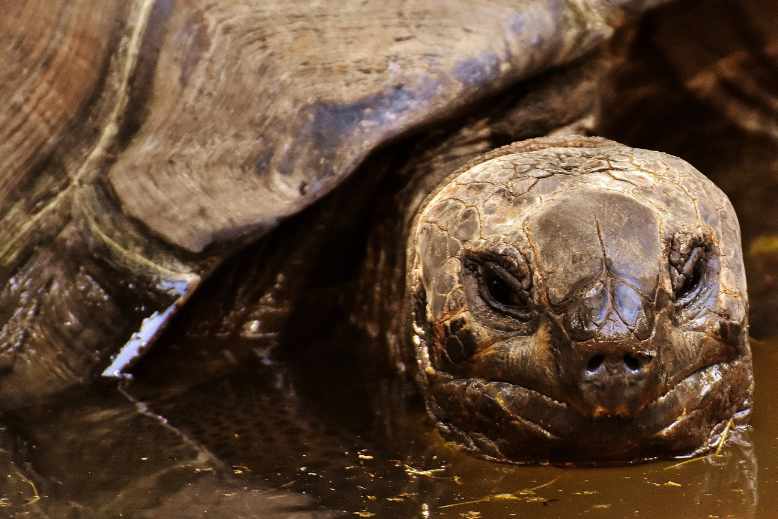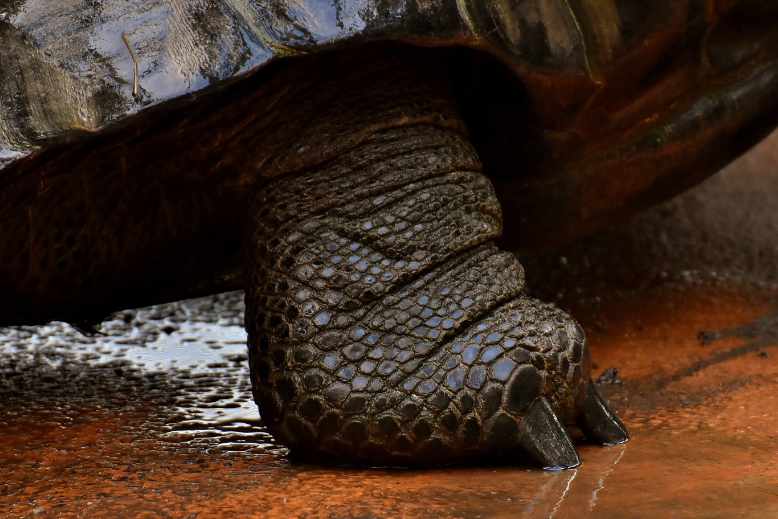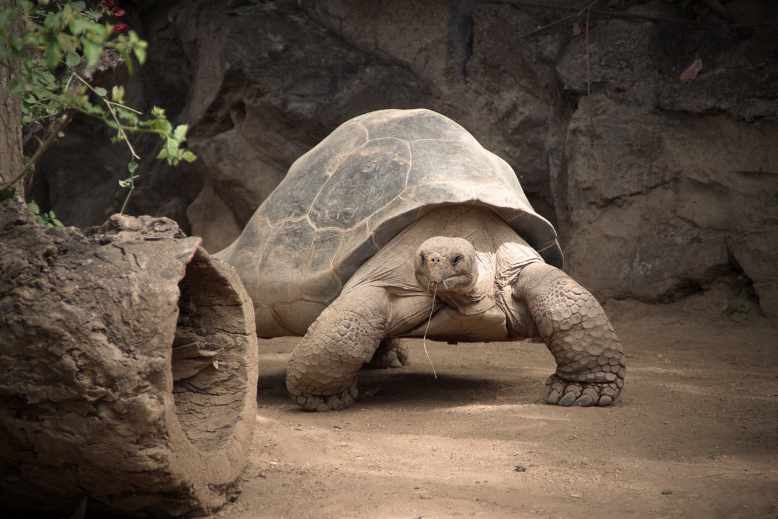Do tortoises like water? Probably not. Knowing that they can’t swim well enough to get back to safety, tortoises try to avoid the water as much as possible. Some tortoise species are known for floating and drifting poorly, but not for too long. Their psychology does not allow them to swim. The ability to float also depends on the specific environment in which the species has evolved. If the natural habitat includes water, the tortoise will like water and is likely to float well. But most tortoise species trundle along the water. Only a few of them reach the shore while others sink and die.
Though some pet tortoises do enjoy an occasional water splash in a cozy bathtub, the owner should never leave a tortoise unattended around any body of water.

Most people have the misconception that all tortoises like water and can swim just like their turtle cousins. So they unintentionally throw tortoises in the water, believing that they are helping this majestic reptile. But the fact is, most of them don’t like water and aren’t able to swim, so they do not make it to the land.
Why do turtles like water and tortoise, being their closest relative, don’t? Why can’t tortoises swim? Do tortoises drink water, and is it safe to bathe a tortoise? Let this be your guide for all of your tortoise and water-related queries.
Keep on reading to learn more!
Do tortoises like water? Is it safe for them?
It’s not like tortoises don’t like water at all. In fact, most tortoises go for shallow waters in the hot weather to cool off. They also enjoy splashing in a stand-still water source like a bathtub or a pond. However, these land reptiles obviate deep water bodies because they cannot swim like turtles and have a risk of drowning. Although some of their species can drift, mostly tortoises are poor swimmers.
If someone throws a tortoise in deep waters in the name of rescuing, they aren’t doing any favor as most tortoises cannot swim and are most likely to endure premature death by drowning. The physical features of a tortoise make it impossible for him to swim. Only a lucky tortoise will be able to float and bump into a dry area alive. That’s why putting a tortoise in any deep water like a deep pond, tidal river, or lake is a big NO.
The natural habitat of a tortoise significantly affects its water preferences and floating abilities. If the surrounding of a tortoise has numerous water sources, the creature is most likely to know how to drift on the water. Tortoise species such as Aldabra and Galapagos live in small islands and are pretty good at floating.
Why can’t tortoises swim but turtles can?
The confusion over the floating and swimming abilities of tortoises and turtles comes from the fact that both reptiles are closely related and have pretty similar appearances. But turtles, being exceptional swimmers, can survive on both water and land, while tortoises can’t swim at all. Why so?
The answer to this question lies in the psychology of tortoises.
Below we have narrowed down three significant factors why turtles like water and can swim why tortoises can’t.
- The shape of flippers and feet
The biggest physical reason a tortoise can’t swim while a turtle can is a difference in appendages. Feet and flippers are critical in determining whether a turtle can swim or not.

Sea turtles have flippers which makes them clumsy on the land, but they are exceptionally capable swimmers. Their flippers help them swim effortlessly.
Since turtles struggle to move on the ground, they rarely leave the water and only head to the shore to lay eggs.
Freshwater turtles have webbed feet. The shape of their feet makes them a good swimmer and helps them propel through the water effortlessly.

Unlike flippers, web feet make it easier for a freshwater turtle to walk on the land. They spend most of their time in the water, but they also like to bask on the ground.
On the other hand, tortoises have sturdy and big elephant-like feet, well-matched to wander on the land. However, these short but thick feet are not suitable for swimming and cannot propel through the water.

- The philosophy of their shells
Another significant factor affecting the swimming abilities of both species is the shell shape. Turtles have flat and lightweight shells that help them cut through the slippery seawater fast. Their exotic-shaped bodies don’t block the water. Instead, it hampers the motion by minimizing the drag friction between the water and the turtle’s carapace. As a result, turtles swim smoothly even in deep waters.
In contrast, land turtles have bulky dome-shaped shells. Their heavy bodies make it impossible for them to swim or to maintain a balance in the water.
- Natural habitat
The natural habitat of a tortoise plays a prominent role in its behavior and preferences. Most turtles grow up in water bodies, so they naturally learn to swim and paddle around.
Tortoises have evolved as land animals. They are adapted to moving effortlessly on the land. Their strong shells and claws are developed in a way that they can fight different predators approaching them on the ground. Tortoises are more comfortable on land than on the water. Their natural habitat is mostly dry, which is one of the main reasons why tortoises prefer staying on the ground.
Will a tortoise drown in water?
Unfortunately, yes. Tortoises are not water animals. Unlike their turtle cousins, tortoises can not hold their breath for extended periods, thus can drown in deep waters. They are just not evolved to swim, and the chances that a tortoise will survive an accidental dip in the deep waters are very scarce.
However, if the conditions are right, a tortoise may not drown. For example, if you throw a tortoise into the ocean, the shelled creature will definitely drown. Yet, if you gently place a tortoise on top of still water, such as a lake, the fellow has some chances to survive. The tortoise just needs to keep floating until he reaches ashore to climb out.
(Be gentle and do not experiment this on your own)
Can tortoises swim or float on water?
Can tortoises swim? No, they can’t. Though some tortoise species know how to float, not all are great divers.
Floating has a lot to do with the age, species, and weight of the tortoise. To some extent, it is related to the stillness of the water source. The rest has to do with the luck of the tortoise. If the tortoise is lucky and conditions are right, it can float, hoping to run into a beach.
Do tortoises drink water?

A simple and obvious answer to the query “Do tortoises drink water” is yes. They do drink water and need it to exist. A tortoise living in a habitat with limited water resources can go several days without having a sip of water. However, tortoises need water like all other reptiles and animals, so their body functions don’t collapse. They need to stay hydrated to get rid of their body waste. Therefore, your pet tortoise must have access to clean water for optimal health.
Tortoises belong to diverse habitats. Most of their species are native to grasslands, deserts, forests, and semi-arid environments. Some of these settings don’t have access to drinking water. Reptiles from such harsh surroundings tend to get most of their hydration through food. But that shouldn’t be the case for your pet tortoise, and they must have a clean bowl of freshwater all the time. If your tortoise stays dehydrated for extended periods, it could suffer from severe health concerns, including kidney disease and articular gout.
Commonly Asked Questions
Do tortoises like to swim?
Tortoises don’t necessarily enjoy swimming. They tend to avoid big water bodies. However, they don’t mind shallow water, and it is not uncommon for them to freshen up in muddy puddles now and then.
Captive tortoises, however, seem to enjoy their time in the bathtub. But it is essential not to leave them unattended around water for even the slightest moment. It won’t take long for your pet to tip over, get his head submerged under and drown.
Can baby tortoises swim?
No. Juvenile tortoises cannot swim either. But that doesn’t mean you won’t be able to see them near water. Hatchlings need to bathe and drink water like any other animal. But if you throw them into the water or if they accidentally fall in, they are most likely to down.
Although adult tortoises can hold their breath for some time, baby tortoises cannot do that. Their bodies are tiny, and their lungs are not very big to support swimming. It’s just not a natural behavior for them.
Can tortoises swim in pools?
A captive tortoise may enjoy a quick splash in a shallow and non-chlorinated pool. But not all tortoises like playing in the water.
It is good to know that chlorine is harmful to animals, so you should never put a turtle or a tortoise in a chlorinated pool. Also, be sure you don’t force any tortoise to swim if the fellow is not willing to do so.
Do tortoises like rain?
Based on the testimonials of numerous tortoise owners, these shelled reptiles do like rain. Although some tortoise species native to tropical rainforests are more acclimated to it, all tortoises have a bit of fun in nature’s shower. They enjoy rinsing their shells and drinking from the freshly made puddles.
Many captive tortoises enjoy spending time under a gentle sprinkler or a hose. They may stick their necks out to feel the rain on their skin.
Is it possible for a tortoise not to drown?
Yes, it is possible.
Most tortoises are unable to make it to the shore. Yet they have been a few cases where tortoises were successful in their battle against the deadly deep water.
How long can a tortoise go without water?
Tortoises are hardy reptiles, but they should not stay dehydrated for more than seven days in low humidity environments. Lack of water intake for more than two days can make your tortoise feel unwell.
Sadly, due to lack of research, many reptile owners do not provide their pets with sufficient food and water, thinking that tortoises can live without these for a long time. However, this belief is not only inaccurate but is also harmful to the welfare of your shelled pet.
Always remember living is different than surviving. And tortoises, like any other pets, need clean water and a proper diet to be in excellent health.
How much water should a tortoise have?
Provide your tortoise access to freshwater every day. But make sure the water isn’t too much for the tortoise to drown in it. A clean bowel with some clean water in it is sufficient to meet your tortoise’s hydration need. Check the water bowl regularly to have an estimate of how much water your pet is drinking. Like many other tortoise owners, you may never notice your pet is drinking but will have an idea.
How often should you bathe tortoises?
You can bathe your adult tortoise 2-3 times a week. Use lukewarm water for bathing purposes as it feels refreshing on their shell. Hatchlings and dehydrated tortoises should be bathed daily until their water deficiency goes away.
Can a tortoise live without water?
Lack of hydration can cause renal system failure in tortoises. No tortoise can live without water for more than a week and may die from dehydration. Therefore, it won’t be wise to deny their freshwater needs.
Final words.
Tortoises with their elephant-like bent legs and heavy shells may seem hardy; they are not sea creatures. These land creatures don’t dislike water, but their physical features make them unable to swim. Therefore, it is not advisable to throw your tortoise in the water for “rescue” purposes. They may be found near water, taking a quick bath, or drinking; they do not swim.




